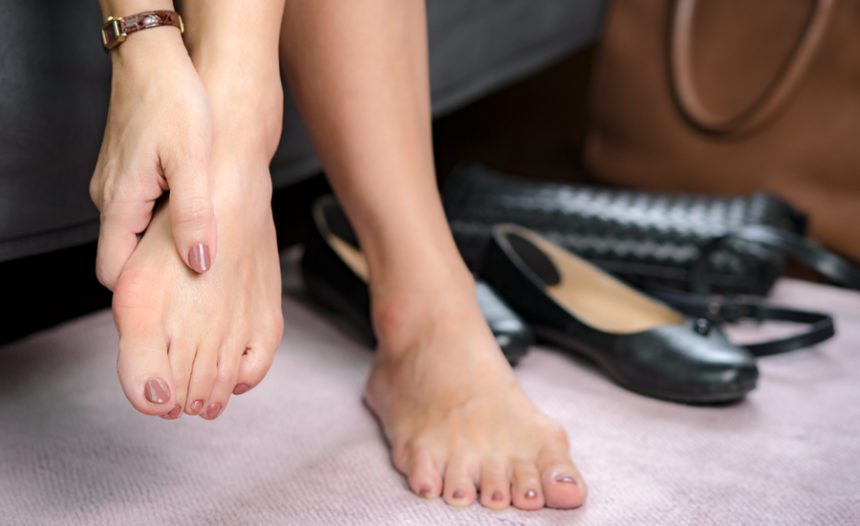When you look down at your bare feet, do you see a big red knot at the base of your big toe?
If your answer is yes, you’re probably looking at a bunion, says UNC Health orthopedic surgeon Joshua Tennant, MD.
“A bunion is a progressive deformity of the bone,” he says. “When the big toe leans in toward the other toes, it makes that joint push out very prominently.” (The word ‘bunion’ comes from the Greek word for turnip because the bump is often red and swollen.)
What to do about it? If it doesn’t bother you, nothing. But bunions can be painful, especially if shoes irritate the bump.
Causes of Bunions: Genetics and Bad Shoes
Bunions and bunionettes (smaller deformities at the base of the little toe) can be caused by several factors, including genetics and ill-fitting shoes.
Bunions are more common in women, but men get them too. One of the potential reasons is that hormones make ligaments loose and stretchy during pregnancy, which can widen a woman’s feet.
About 70 percent of people who develop bunions have a family history of the joint deformity. This is especially true of bunions that develop in children and teens. People with genetic conditions including weak connective tissue, a short Achilles tendon, short calf muscles, rheumatoid arthritis and flat feet are more likely to develop bunions.
“Thank your parents,” Dr. Tennant says. “There’s a genetic predisposition to the way ligaments stretch.”
Most people who have bunions have them on both feet, he says, but one side may be worse than the other.
Finally, there’s a risk factor within your control: your footwear. Pointy-toe shoes and high heels may look good, but your feet pay the price.
“The types of shoes we wear may cause bunions,” Dr. Tennant says, and once bunions form, these shoes “can definitely make symptoms worse.”
Avoid wearing tight shoes that squeeze your toes, he says. High heels jam your toes into the front of the shoe, and if there’s no room for the toes to spread out normally, they’re going to hurt.
Finding a Doctor to Fix Your Bunions
Even though you can look at your feet and know whether you have bunions, your doctor will take an X-ray while you are standing up to diagnose them for sure.
You can see either a podiatrist or an orthopedic surgeon for bunions.
Doctors of podiatric medicine (DPM) attend podiatry school for four years and concentrate on the feet and ankles. Podiatrists are required to complete a 36-month residency program that combines medical and surgical experiences for the foot and ankle.
Orthopedic surgeons complete four years of medical school, then a five-year residency in orthopedic surgery. Many (including those like Dr. Tennant who specialize in the feet and ankles) complete another year of fellowship training in a specific part of the body (including the hands, knees, hips and spine).
Both kinds of specialists are trained to do surgery, and both are trained to look for nonsurgical treatments.
Treatment Options for Bunions
The first thing to do to treat bunions is to take a look at your shoes, Dr. Tennant says. “Wearing shoes that fit right can slow down the progression of bunions,” he says. “They need to have wide toe boxes and good arch support. They may not be the most stylish shoes around, but at least you’ll have less pain when you walk.”
Dr. Tennant offers these tips when shoe shopping (or deciding what to choose in your closet):
- Choose shoes with a wide toe box (the part of the shoe where your toes sit).
- Avoid heels as much as you can.
- Choose materials that “give,” especially over the bunion, such as mesh or soft leather. If you have a stiff leather shoe, talk to a shoe repair shop about stretching the leather over the bunion.
- If you have arthritis in your feet, consider shoes with “rocker” bottoms that allow your foot to rock slightly while walking.
If you’re still in pain after choosing better shoes, talk to your doctor about orthotics, or shoe inserts. Before you pay for custom orthotics, you might try over-the-counter inserts you can buy at drugstores, which also sell bunion pads that prevent rubbing.
Splints or toe spacers can also “make your feet feel better, at least for a little while,” Dr. Tennant says. “But they don’t make the alignment of the bones any better, and most won’t fit into regular shoes. If you have pain at night, they might help.”
When to Have Surgery on a Bunion
“Never do surgery on a painless bunion,” Dr. Tennant says. “All surgery has its risks.”
Consider surgery, he says, if:
- You have significant pain that limits your daily activities, including walking.
- You have chronic big toe inflammation and swelling that doesn’t improve with rest or medications.
- You have another toe deformity caused by the big toe drifting in and causing other toes to cross over each other.
Bunion surgery is commonly done on an outpatient basis. Sometimes doctors use minimally invasive techniques; other times, patients may require bigger incisions and the use of plates or screws to hold the bones in place.
Recovery time depends on the type and extent of surgery, Dr. Tennant says.
“Some doctors want their patients to be off the foot entirely for two months,” he says. “You may need a walker or crutches for several months. Expect swelling in the foot for six to nine months.”
Often, the foot is placed in a cast or brace to keep the bones in the correct position during healing. It’s critical for patients to follow their doctors’ instructions carefully to ensure proper healing of the bone.
If someone needs surgery on both feet, Dr. Tennant says, the patient usually will have one done, then have surgery on the other foot once the first one has healed.
If you have foot pain, talk to your doctor, or find one near you.

